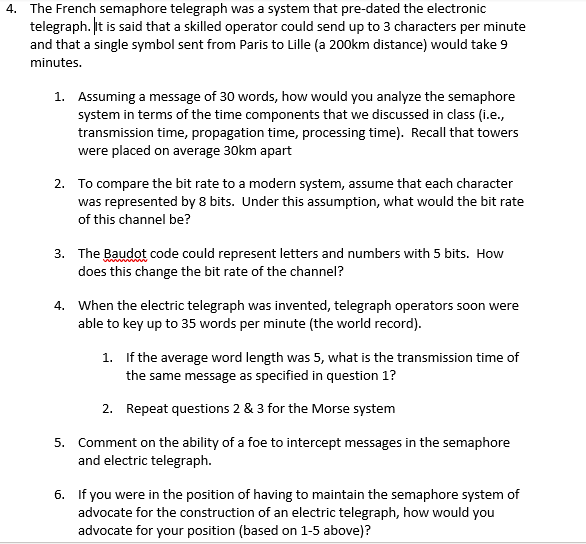


1. Modern data analytics projects involve the analysis of very large data sets (hence the term "big data analytics". Suppose you collected data at various geographically distant sites (A-G) 1. Suppose further that you could perform your analytics at one site only. If the sites were interconnected as below, which site would that be 1. Create an adjacency matrix (in Gephi, if you wish) 2. Choose one of the centrality measures and make the case why that is the right one 3. Choose the best node based on this. 2. Assume that all nodes have "store and forward" capability. 1. If each dataset was 1 terabyte (1012 bytes) how long would it take for all of the data to arrive at the processing site if each link was 1 Gigabit/second? 2. 10 Gigabits/second? 3. What kinds of delay can you calculate based on the data you have? 3. Suppose you decided to instead to send 1 TB flash cards via overnight mail (5pm drop off, delivered by 10am the next day) from each location directly to the destination? 1. How does this change in the communication strategy change the connectivity graph (draw a picture)? 2. What is the bit rate of each of these channels? The French semaphore telegraph was a system that pre-dated the electronic telegraph. lit is said that a skilled operator could send up to 3 characters per minute and that a single symbol sent from Paris to Lille (a 200km distance) would take 9 minutes. 1. Assuming a message of 30 words, how would you analyze the semaphore system in terms of the time components that we discussed in class (i.e., transmission time, propagation time, processing time). Recall that towers were placed on average 30km apart 2. To compare the bit rate to a modern system, assume that each character was represented by 8 bits. Under this assumption, what would the bit rate of this channel be? 3. The Baudot code could represent letters and numbers with 5 bits. How does this change the bit rate of the channel? 4. When the electric telegraph was invented, telegraph operators soon were able to key up to 35 words per minute (the world record). 1. If the average word length was 5, what is the transmission time of the same message as specified in question 1? 2. Repeat questions 2 & 3 for the Morse system 5. Comment on the ability of a foe to intercept messages in the semaphore and electric telegraph. 6. If you were in the position of having to maintain the semaphore system of advocate for the construction of an electric telegraph, how would you advocate for your position (based on 1-5 above)? 1. Modern data analytics projects involve the analysis of very large data sets (hence the term "big data analytics". Suppose you collected data at various geographically distant sites (A-G) 1. Suppose further that you could perform your analytics at one site only. If the sites were interconnected as below, which site would that be 1. Create an adjacency matrix (in Gephi, if you wish) 2. Choose one of the centrality measures and make the case why that is the right one 3. Choose the best node based on this. 2. Assume that all nodes have "store and forward" capability. 1. If each dataset was 1 terabyte (1012 bytes) how long would it take for all of the data to arrive at the processing site if each link was 1 Gigabit/second? 2. 10 Gigabits/second? 3. What kinds of delay can you calculate based on the data you have? 3. Suppose you decided to instead to send 1 TB flash cards via overnight mail (5pm drop off, delivered by 10am the next day) from each location directly to the destination? 1. How does this change in the communication strategy change the connectivity graph (draw a picture)? 2. What is the bit rate of each of these channels? The French semaphore telegraph was a system that pre-dated the electronic telegraph. lit is said that a skilled operator could send up to 3 characters per minute and that a single symbol sent from Paris to Lille (a 200km distance) would take 9 minutes. 1. Assuming a message of 30 words, how would you analyze the semaphore system in terms of the time components that we discussed in class (i.e., transmission time, propagation time, processing time). Recall that towers were placed on average 30km apart 2. To compare the bit rate to a modern system, assume that each character was represented by 8 bits. Under this assumption, what would the bit rate of this channel be? 3. The Baudot code could represent letters and numbers with 5 bits. How does this change the bit rate of the channel? 4. When the electric telegraph was invented, telegraph operators soon were able to key up to 35 words per minute (the world record). 1. If the average word length was 5, what is the transmission time of the same message as specified in question 1? 2. Repeat questions 2 & 3 for the Morse system 5. Comment on the ability of a foe to intercept messages in the semaphore and electric telegraph. 6. If you were in the position of having to maintain the semaphore system of advocate for the construction of an electric telegraph, how would you advocate for your position (based on 1-5 above)









